Search for information
Cambodia's Intangible Cultural Heritages on UNESCO ListsCambodia's Intangible Cultural Heritages on UNESCO Lists
April 23, 2025, 2:23 pm EDT
The Royal Ballet of Cambodia, also known as Khmer classical dance, is renowned for its elegant hand gestures and stunning costumes. It has had a close connection with the Khmer court for over a thousand years. Traditionally, performances accompanied royal ceremonies and rituals, such as coronations, weddings, funerals, or Khmer festivals. This art form, which was on the verge of extinction in the 1970s, is highly cherished by many Cambodians.
The dance plays a sacred and symbolic role, embodying traditional values of elegance, respect, and spirituality. Its repertoire continues the legends related to the origins of the Khmer people. As a result, Cambodians have long regarded this tradition as a symbol of Khmer culture. In the classical repertoire, there are four distinct character types: the woman (Neang), the man (Neayrong), the giant (Yeak), and the monkey (Sva). Each character has its unique color, costume, makeup, and mask.
Dancers spend years in intensive training to master the gestures and postures, which correspond to a wide range of human emotions, from fear and anger to love and joy. An orchestra accompanies the dance, and a female chorus sets the narrative, highlighting the emotions imitated by the dancers, who are seen as messengers conveying the king's messages to the gods and ancestors.
During the oppressive rule of the Khmer Rouge, the Royal Ballet nearly ceased to exist, as the Khmer Rouge almost eliminated all the dance masters and musicians. Immediately after Pol Pot's regime fell in 1979, the ballet troupe reemerged, and performances of the ancient repertoire were resumed. While the ballet has regained some of its former glory, it still faces numerous challenges, such as a lack of funding, suitable performance venues, competition from modern media, and the risk of becoming a mere tourist attraction.
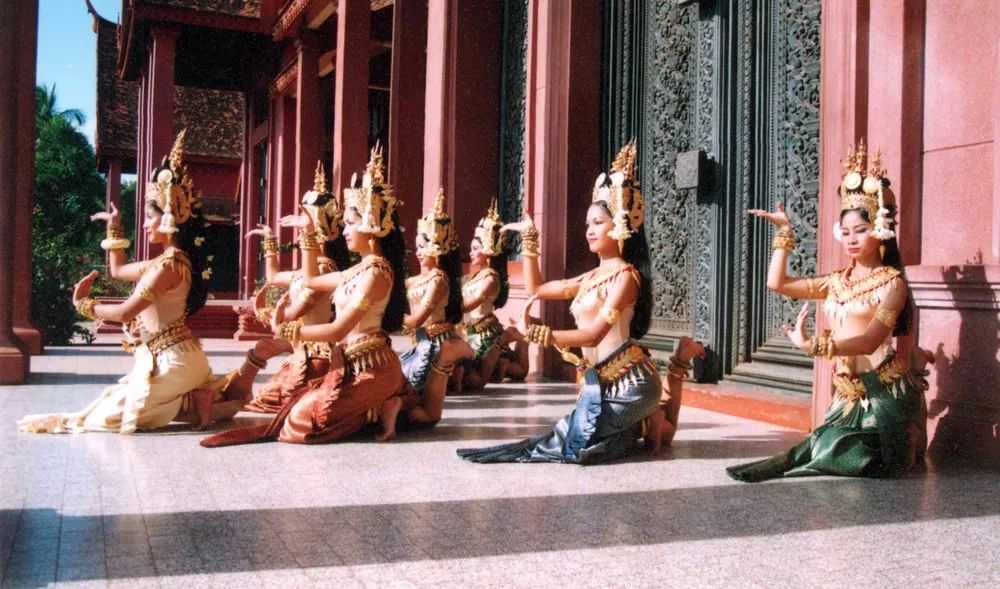
Sbek Thom is a form of Khmer shadow theatre. The shadow puppets, which are up to two meters tall, are non-articulated singing and dancing puppets made from cut-out leather. Even before the Angkor period, Sbek Thom was considered sacred, alongside the Royal Ballet and mask theatre. To pay homage to the gods, performances could only be held three to four times a year on specific occasions, such as the Khmer New Year, the king's birthday, or memorial ceremonies for notable figures.
After the fall of Angkor Wat in the 15th century, the shadow theatre evolved from a ritual activity into an art form while retaining its ritual norms. The puppets are made from a single piece of leather through a special ceremony, and each character represents a deity. The leather is dyed with a solution made from the bark of a local tree. Craftsmen draw the desired figures on the tanned leather, cut them out, paint them, and then attach them to two bamboo sticks so that the dancers can control the puppets.
Traditional performances are held outdoors at night, either in the fields or beside a pagoda. A large white screen is placed between two tall bamboo screens in front of a large furnace, which has now been replaced by a projection lamp. The silhouettes of the puppets are projected onto the white screen. Animators bring the puppets to life with precise and specific dance steps. The performance is accompanied by an orchestra and features two narrators.
The stories are inspired by the Khmer version of the Ramayana, and the stage scenes of this epic can last for several nights, with a single performance requiring up to 160 puppets. Many of these puppets were destroyed during the Khmer Rouge regime, when this sacred art form was on the verge of disappearing. Since 1979, thanks to a few surviving artists, Sbek Thom has gradually regained its vitality. So far, three shadow theatres have successfully risen from the ruins, ensuring the transmission of knowledge and skills, including those related to puppet making.
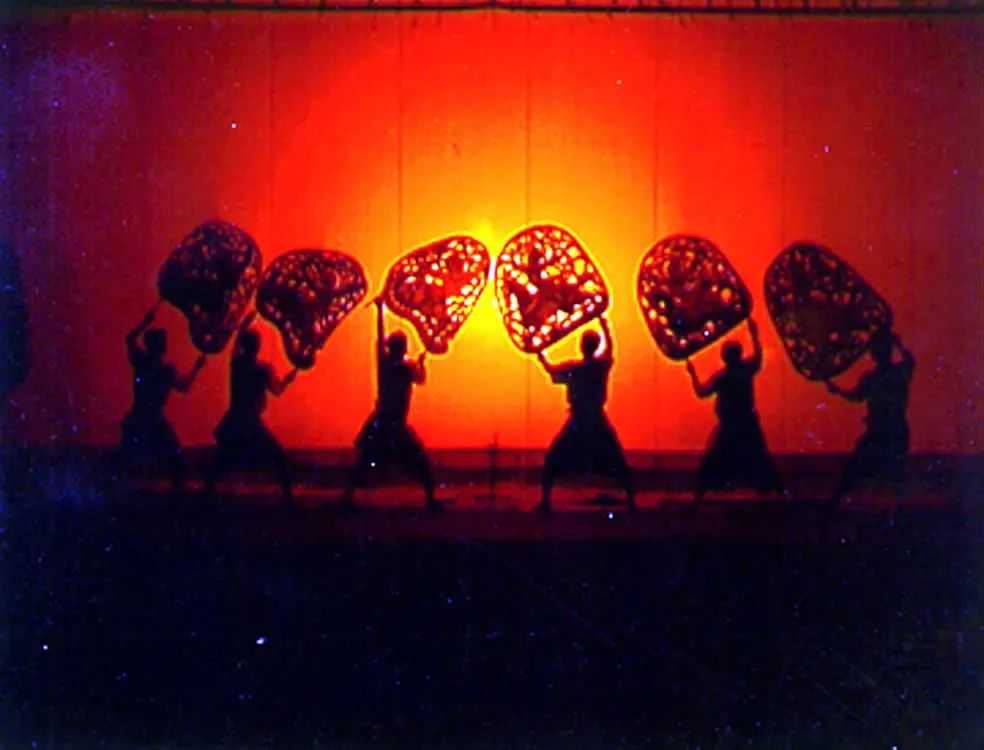
Source: Images from the Internet, if there is any infringement, please contact the removal of
In the rice-growing cultures of East and Southeast Asia, tugging rituals and games are conducted within communities to ensure a good harvest and prosperity. These activities promote social unity, provide entertainment, and mark the beginning of a new agricultural cycle. Many tugging rituals and games also carry profound religious meanings.
The games are mostly divided into two teams, each holding one end of the rope and trying their best to pull it towards their side. This activity deliberately minimizes competition and does not emphasize winning or losing. The traditions are maintained to promote the well-being of the community and to remind its members of the importance of cooperation.
Many tugging competitions bear the marks of agricultural rituals, symbolizing the forces of nature, such as the sun and rain, and also incorporate mythological elements or purification ceremonies. Tugging rituals and games are usually held in front of a village's public building or shrine, preceded by a memorial ceremony for the local protective deities. Village elders play a leading role in organizing the games and accompanying rituals and guiding the young people. These activities also help strengthen the unity, sense of belonging, and identity among community members.
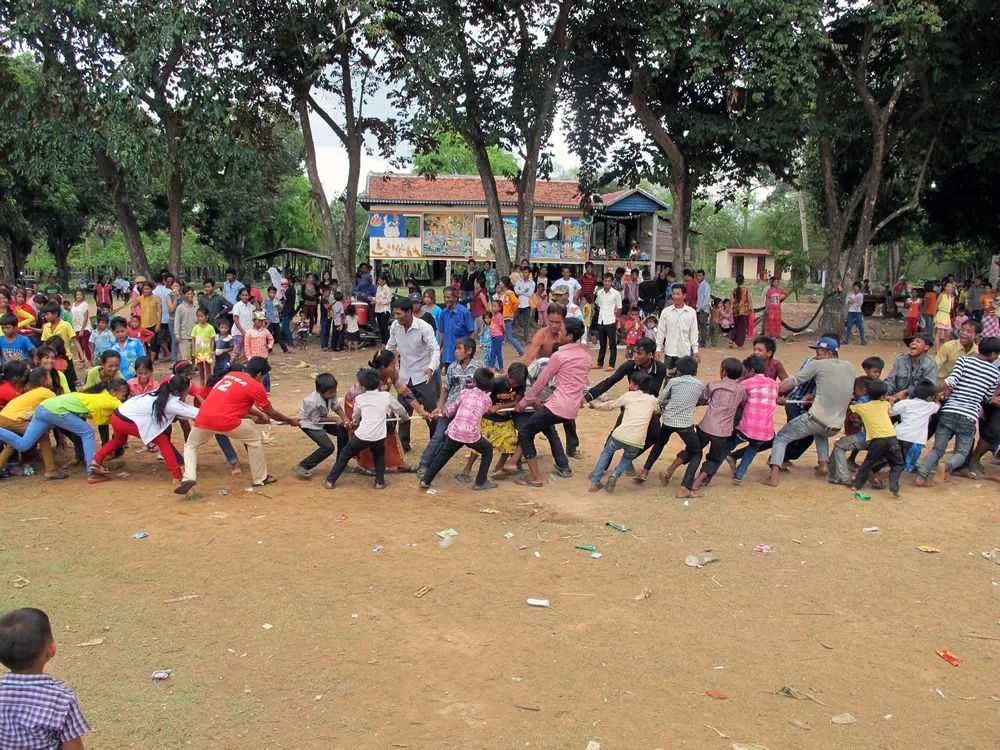
Chapei Dang Veng is a musical tradition in Cambodia that is closely linked to the lives, customs, and beliefs of the Cambodian people. It features the Chapei (a lute often played at cultural festivals) accompanied by singing. The lyrics cover a wide range of topics, from education and social commentary to satire, and incorporate traditional poetry, folk stories, or Buddhist tales.
This tradition is believed to have multiple functions within the Cambodian community, such as preserving traditional rituals, spreading social, cultural, and religious knowledge and values, exposing people to the ancient Khmer language, creating a space for social and political commentary, spreading joy, bridging generations, and enhancing social cohesion.
In addition to musical talent, the skills required to become a Chapei Dang Veng performer include wit, the ability to improvise, and storytelling skills. Although performers are generally male, there is no gender restriction. The tradition is passed down orally within families and through informal master-apprentice relationships. Today, few performers practice this art form, and there are even fewer masters. The Khmer Rouge regime severely affected the number of inheritors and disrupted the transmission of this custom, leaving a long-lasting impact, and the tradition is at risk of being lost.
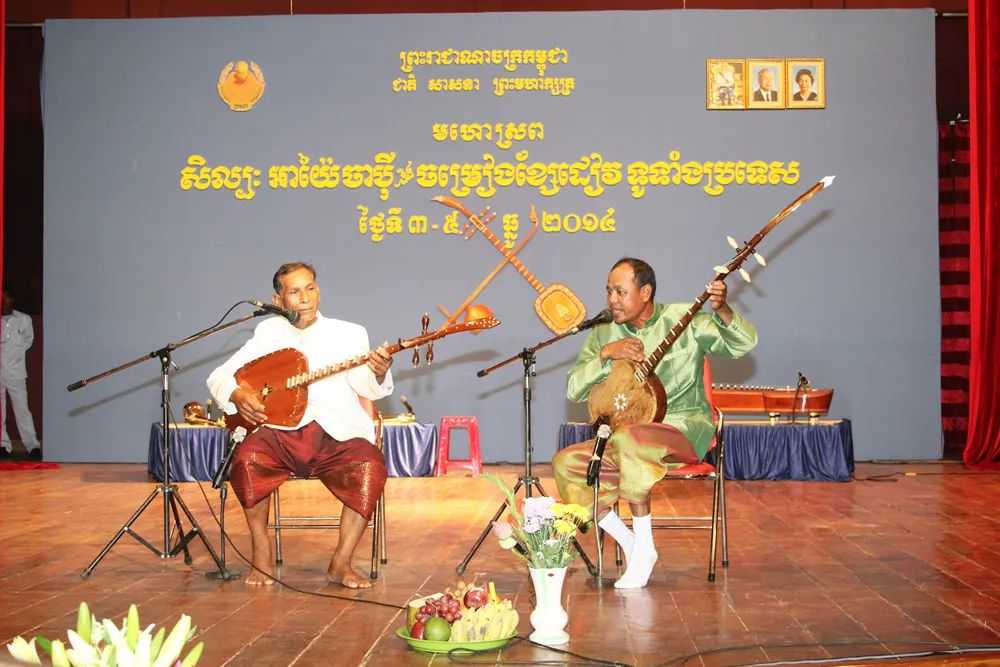
Source: Images from the Internet, if there is any infringement, please contact the removal of
The Lkhon Khol Wat Svay Andet mask dance exists in the community of Wat Svay Andet, located on the Mekong River about 10 kilometers east of Phnom Penh, surrounding a Buddhist temple. It is performed by masked men accompanied by a traditional orchestra and melodious recitation. The specific purpose is to appease the Tutelary Deity (the protective deity of a place and its people), thus bringing blessings and prosperity to the community, the land, and the harvest.
When the mask dance is performed, a medium is present to facilitate interaction between the Tutelary Deity performer and the villagers. When the deity is satisfied with the performance, the villagers will receive blessings; otherwise, the dancers stop, the music continues, and the audience remains quiet, listening carefully to the deity.
The performance of the mask dance serves a ritual purpose, mainly related to the rice-growing cycle and the needs of an agricultural society. The dance methods are passed down orally within the community. The chief monk and a retired primary school headmaster have recently opened additional weekend classes and started writing scripts for selected episodes. However, after generations of transmission, several factors now threaten the survival of this activity, including environmental factors, insufficient resources, population outflow from the community, and a 14-year interruption in transmission from 1970 to 1984 due to war and the Khmer Rouge regime.
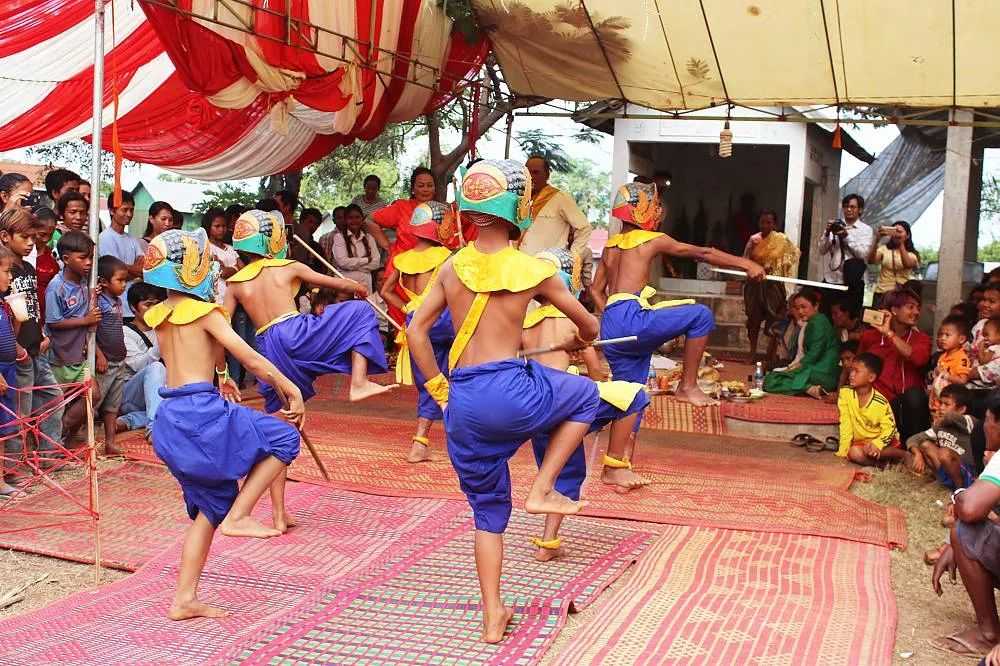
Kun Lbokator is a martial art that can be traced back to the 1st century AD. Its purpose is to cultivate the spiritual and physical strength, as well as discipline, of practitioners through self-defense techniques and a non-violent philosophy. The training in Kun Lbokator is not just about physical skills; more importantly, it involves mental training in respecting nature and behaving appropriately in society.
Some masters of Kun Lbokator teach apprentices about their roles and responsibilities in society, which also include the roles of healing and protection. They make the apprentices believe that once they master the necessary skills, they can protect vulnerable communities and the natural environment and defend justice and peace. Kun Lbokator still thrives locally as part of local ceremonies to worship deities and other festival activities, together with elements such as dance, music, and traditional medicine.

Source: Images from the Internet, if there is any infringement, please contact the removal of
The Krama is a woven textile associated with the traditional customs and cultural expressions of daily life in Cambodia. It is a rectangular fabric made of cotton or silk, forming various grid patterns. The white, yellow, red, and blue dyes used are extracted from natural vegetation and insects, and the fabric is handwoven on traditional looms.
The Krama has a wide range of applications in social and cultural life. It is used in all walks of life in daily life, such as a scarf, belt, blanket, headscarf, lower garment, decorative cloth, and baby hammock. It is also used in rituals, ceremonies, and festival activities, as well as for food preparation and healthcare.
While the Krama is mainly made by women, men are involved in growing and harvesting cotton, collecting dye materials, and maintaining the handlooms. In the past, most women knew how to weave the Krama and passed on the knowledge and skills to their daughters. Nowadays, professional groups and makers undertake the task of weaving the Krama. Educational institutions play an important role in transmitting the relevant skills and knowledge through training courses and workshops.
The Krama production chain is based on a collaborative approach, promoting social cohesion, maintaining peace, and enhancing Cambodia's social and cultural identity.


UK officially closes tax leakage loophole, taxing nationals globally
UK officially closes tax leakage loophole, taxing nationals globallymore

Natural Allure: Stunning Shots of an Amateur Model in Foreign Beauty Lifestyle Photos - Issue 113
In the latest installment of Foreign Beauty Lifestyle Photos - Issue 113, we are treated to a collection of remarkable pictures featuring an amateur model who has caught the attention of photography enthusiasts worldwide. These photos, taken by a talented lensman, capture the model in various everyday settings, highlighting her natural beauty and unique charm.more

Foreign Beauty's Life Photos: Issue 101 - Featuring the Photographs of an Amateur Model
The 101st issue of foreign beauty's life photos mainly showcases the photography works of an amateur model. These photos capture various aspects of the model's life, presenting her unique charm and the vivid moments in her daily life. It provides a fascinating view into the world of an amateur model and brings a fresh perspective on the concept of beauty through her images.more

Botswana Golden Grand Prix 2026 to Be Upgraded as Precursor to World Relays
Botswana Golden Grand Prix 2026 to Be Upgraded as Precursor to World Relaysmore
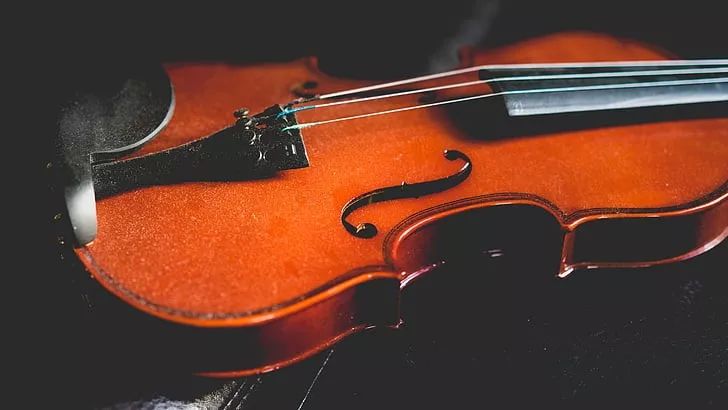
Yamaha and the Global Musical Instrument Industry: A Tale of Japanese and German Dominance
The global musical instrument industry is largely dominated by Japan and Germany, with Japanese conglomerate Yamaha standing as an unchallenged titan. Renowned for its craftsmanship, innovation, and unparalleled quality, Yamaha has solidified its position as the world’s leading brand, shaping the landscape of classical, contemporary, and professional music scenes alike.more

Google's Willow Quantum Chip: A Leap Forward in Quantum Computing
In the realm of quantum computing, Google has recently unveiled a significant breakthrough with the launch of its Willow quantum chip. To truly grasp the magnitude of this achievement, one must first understand a central challenge in quantum computing - the fragility of qubits. Qubits are extremely sensitive and vulnerable to interference from the surrounding environment.more

2030 French Alps Olympics Appoints New CEO
The organizing committee of the 2030 Winter Olympics and Paralympics in the French Alps has recently confirmed the appointment of Cyril Linette as its new chief executive officer. Linette will work under the leadership of Edgar Grospiron, the president of the 2030 French Alps Olympics, and be responsible for overseeing the committee's operations, legal and financial affairs.more

In Longyearbyen, Norway: Where Life and Death Are Regulated by Law
In the remote town of Longyearbyen, nestled within the Arctic Circle in Norway, an extraordinary set of regulations governs life and death. This unique approach stems from the town's specific geographical and environmental conditions, making it a place where the boundaries between the living and the deceased are strictly defined by law.more

